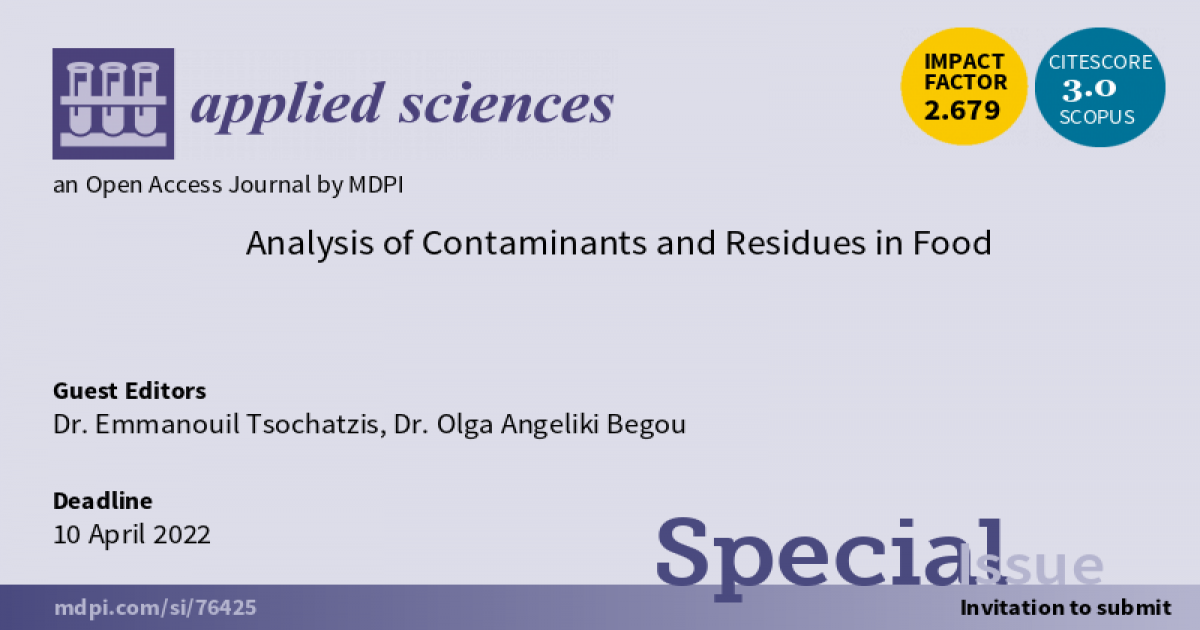Analysis of Contaminants and Residues in Food
A special issue of Applied Sciences (ISSN 2076-3417). This special issue belongs to the section "Food Science and Technology".
Deadline for manuscript submissions: closed (10 April 2022) | Viewed by 14198

Special Issue Editors
Interests: analytical chemistry; food contact materials (intentionally added substances (IAS) and non-intentionally added substances (NIAS)); sustainability and recycling of plastics
Special Issues, Collections and Topics in MDPI journals
2. Biomic_AUTh, Center for Interdisciplinary Research and Innovation (CIRI-AUTH), Balkan Center, B1.4, 57001 Thermi, Greece
Interests: mass spectrometry; validation; analytical chemistry; high-performance liquid chromatography (HPLC); gas chromatography; analytical method development; quality control of chemicals, foods, and pharmaceuticals; metabonomic/metabolomic analysis for biomarker discovery; novel sample pretreatment techniques
Special Issues, Collections and Topics in MDPI journals
Special Issue Information
Dear Colleagues,
We are organizing a Special Issue titled "Analysis of Contaminants and Residues in Food" in Applied Sciences (MDPI).
The food supply chain contains several steps that start with the farm and end with the forks of consumers. Within this chain, pesticide application, veterinary drug administration, environmental and storage conditions, process-induced changes, formation of undesired and toxic compounds, use of food additives, profit-seeking practices, and final food packaging materials can potentially lead to contamination of the food (either intentionally or non-intentionally), and hazardous chemical substances or their residues may end up in the final food product. Hence, there is a strong need for suitable and reliable analytical methods for the detection and quantitative analysis of all these targeted analytes in order to ensure food quality and safety, as well as fair trade and fair competition. Therefore, development, optimization, and validation of analytical methods are of continuous interest and effort.
We would be delighted if you could respond and contribute a manuscript to this Special Issue. Detailed instructions for on-line submission are below. Please closely follow the Guide to Authors, which can be found at the respective Journal’s website.
The topics of interest for this Special Issue include but are not limited to the following fields (in alphabetical order):
- allergens in foods;
- antibiotics in food products;
- endocrine disrupting substances;
- food additives;
- food colorants;
- food contact materials;
- mycotoxins;
- pesticides;
- polyaromatic hydrocarbons (PAH);
- process-induced changes and oxidation products.
Dr. Emmanouil Tsochatzis
Dr. Olga Angeliki Begou
Guest Editors
Manuscript Submission Information
Manuscripts should be submitted online at www.mdpi.com by registering and logging in to this website. Once you are registered, click here to go to the submission form. Manuscripts can be submitted until the deadline. All submissions that pass pre-check are peer-reviewed. Accepted papers will be published continuously in the journal (as soon as accepted) and will be listed together on the special issue website. Research articles, review articles as well as short communications are invited. For planned papers, a title and short abstract (about 100 words) can be sent to the Editorial Office for announcement on this website.
Submitted manuscripts should not have been published previously, nor be under consideration for publication elsewhere (except conference proceedings papers). All manuscripts are thoroughly refereed through a single-blind peer-review process. A guide for authors and other relevant information for submission of manuscripts is available on the Instructions for Authors page. Applied Sciences is an international peer-reviewed open access semimonthly journal published by MDPI.
Please visit the Instructions for Authors page before submitting a manuscript. The Article Processing Charge (APC) for publication in this open access journal is 2400 CHF (Swiss Francs). Submitted papers should be well formatted and use good English. Authors may use MDPI's English editing service prior to publication or during author revisions.
Keywords
- allergens in foods
- antibiotics in food products
- endocrine disrupting substances
- food additives
- food colorants
- food contact materials
- mycotoxins
- pesticides
- polyaromatic hydrocarbons (PAH)
- process-induced changes and oxidation products






